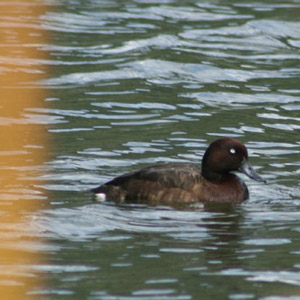Magazine | Études
La redécouverte du Fuligule de Madagascar

Fuligule de Madagascar (Aythya innotata) mâle, site exact non précisé, Madagascar.
Photographie : Lily-Arison Rene de Roland / The Peregrine Fund
Introduction
L’île de Madagascar est connue pour ses lémuriens, mais aussi pour son grand nombre d’oiseaux endémiques. Mais une grande proportion d’entre elles sont menacées par la destruction de leur habitat. C’est le cas du Fuligule de Madagascar (Aythya innotata),qui était considéré comme disparu par la plupart des organismes, sa dernière donnée confirmée datant de 1991, sur le lac Alaotra, un site très fortement dégradé par l’agriculture. Mais des biologistes du Peregrine Fund ont annoncé le 20 novembre 2006 avoir récemment observé neuf adultes et quatre jeunes au cours d’une étude sur un lac isolé du bord de la Grande Ile.
Nous publions ici les photos de Lily-Arison Rene de Roland, responsable du Peregrine Fund’s Madagascar Project. Le 3 avril 2007, Sam The Seing, biologiste et vice-président de l’ASITY, a apporté des compléments à cet article.
Abstract
The 20th of November 2006, biologists for The Peregrine Fund have announced the sight of 13 Madagascar Pochards (Aythya innotata), a medium-sized diving duck that was considered extinct by many authorities until this current sighting. National Director for The Peregrine Fund’s Madagascar Project, Lily-Arison Rene de Roland, and field biologist, Thé Seing Sam, discovered the rare bird while conducting avian surveys in a remote part of northern Madagascar. They observed nine adults and four young that appeared to be nearly two weeks of age. Since their initial sighting, Rene de Roland and Sam have returned to the site to collect additional data and observations.
The last confirmed sighting of the species was more than a decade and a half ago at Lake Alaotra on the Central Plateau of Madagascar in 1991. The single male was captured and kept in Antananarivo Zoological and Botanical Gardens until its death one year later. Decline of the Madagascar Pochard is likely to have begun in the 1940s and 1950s in connection with degrading lake and marshland habitat from introduced plant and fish species, conversion to rice paddies, and burning. The last certain record of multiple birds (approximately 20) on Lake Alaotra is from June 1960. Little is known about the Madagascar Pochard, an extremely secretive and often solitary bird that prefers shallow and marshy habitat. Found only on Madagascar, most of the species’ behavior and life cycle is still unknown.
Poursuivez la lecture de cet article, en vous abonnant dès maintenant !
Découvrez les Archives d’Ornithomedia.com
Pour seulement 10,00 €TTC/an (ou 6,00 € les 6 mois)
Profitez de plusieurs centaines d’articles en accès illimité et sans aucun engagement.
Compléments
À lire aussi sur Ornithomedia.com
- Observer les oiseaux dans la région Melaky (Madagascar)
- Description d’une nouvelle espèce de râle à Madagascar
- Le Grèbe roussâtre a disparu et le Grèbe castagneux est impliqué
À lire sur le web
Le site web du Peregrine Fund : www.peregrinefund.org
Ouvrages recommandés
- Birds of Madagascar: A Photographic Guide de P. Morris et al.
- Guide des oiseaux de Madagascar de O. Langrand
- Mammals of Madagascar (Relié) de Nick Garbutt, Yale University Press (septembre 1998)
- Amphibians and Reptiles of Madagascar, the Mascarene, the Seychelles, and the Comoro Islands (Relié) de Friedrich-Wilhelm Henkel, Wolfgang Schmidt, Michael Knothig, Klaus Liebel, Roland Zobel, Hinrich et Ph.D. Kaiser




Aucun commentaire sur ce sujet
Participer à la discussion !